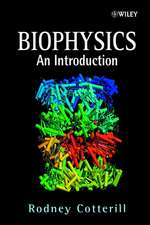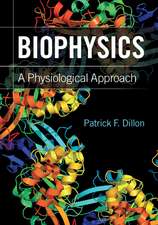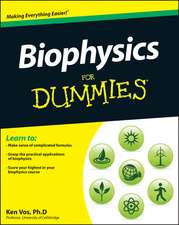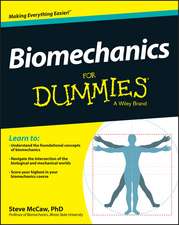Molecular Biophysics for the Life Sciences: Biophysics for the Life Sciences, cartea 6
Editat de Norma Allewell, Linda O. Narhi, Ivan Raymenten Limba Engleză Hardback – 28 sep 2013
| Toate formatele și edițiile | Preț | Express |
|---|---|---|
| Paperback (1) | 950.03 lei 6-8 săpt. | |
| Springer – 23 aug 2016 | 950.03 lei 6-8 săpt. | |
| Hardback (1) | 954.45 lei 6-8 săpt. | |
| Springer – 28 sep 2013 | 954.45 lei 6-8 săpt. |
Preț: 954.45 lei
Preț vechi: 1163.97 lei
-18% Nou
Puncte Express: 1432
Preț estimativ în valută:
182.65€ • 198.34$ • 153.43£
182.65€ • 198.34$ • 153.43£
Carte tipărită la comandă
Livrare economică 22 aprilie-06 mai
Preluare comenzi: 021 569.72.76
Specificații
ISBN-13: 9781461485476
ISBN-10: 1461485479
Pagini: 260
Ilustrații: XII, 397 p. 132 illus., 70 illus. in color.
Dimensiuni: 155 x 235 x 30 mm
Greutate: 0.7 kg
Ediția:2013
Editura: Springer
Colecția Springer
Seria Biophysics for the Life Sciences
Locul publicării:New York, NY, United States
ISBN-10: 1461485479
Pagini: 260
Ilustrații: XII, 397 p. 132 illus., 70 illus. in color.
Dimensiuni: 155 x 235 x 30 mm
Greutate: 0.7 kg
Ediția:2013
Editura: Springer
Colecția Springer
Seria Biophysics for the Life Sciences
Locul publicării:New York, NY, United States
Public țintă
Professional/practitionerCuprins
Introduction: Molecular Biophysics and the Life Sciences.- Structural, Physical, and Chemical Principles.- Part I. The Experimental Tools of Molecular Biophysics.- Optical Spectroscopic Methods for the Analysis of Biological Macromolecules.- Diffraction and Scattering of X-Rays and Neutrons.- Nuclear Magnetic Resonance Spectroscopy.- Electron Paramagnetic Resonance Spectroscopy.- Mass Spectrometry.- Single Molecule Methods.- Part II. Biological Macromolecules as Molecular Machines: Three Examples.- Helicase Unwinding at the Replication Fork.- Rotary Motor ATPases.- Biophysical approaches to understanding the action of myosin as a molecular machine.- Part III. Future Prospects.- Future Prospects.
Recenzii
From the reviews:
“This valuable work describes the major methods used for characterizing biological macromolecules. The book is very readable and well organized, with 12 succinct chapters. … Summing Up: Highly recommended. Upper-division undergraduates and above.” (J. A. Kelly, Choice, Vol. 51 (10), June, 2014)
“This valuable work describes the major methods used for characterizing biological macromolecules. The book is very readable and well organized, with 12 succinct chapters. … Summing Up: Highly recommended. Upper-division undergraduates and above.” (J. A. Kelly, Choice, Vol. 51 (10), June, 2014)
Notă biografică
Dr. Norma M. Allewell is Professor of Cell Biology and Molecular Genetics and Affiliate Professor of Chemistry and Biochemistry at the University of Maryland, where she served as Dean of the College of Chemical and Life Sciences for a decade. Her research focuses on protein structure, function and dynamics, and metabolic regulatory mechanisms and diseases.
Dr. Linda Narhi is a Scientific Executive Director in the Product Attribute Science Group at Amgen, where her responsibilities include solution stability assessment of all protein-based therapeutic candidates, and developing and implementing predictive assays for protein stability to process, storage, and delivery conditions.
Dr. Ivan Rayment is Professor of Biochemistry at the University of Wisconsin-Madison, where he holds the Michael G. Rossmann Professorship in Biochemistry. He has a wide range of interests in structural biology and has made seminal contributions to our understanding of the structural basis of motility, enzyme evolution, cobalamin biosynthesis, and transposition.
Dr. Linda Narhi is a Scientific Executive Director in the Product Attribute Science Group at Amgen, where her responsibilities include solution stability assessment of all protein-based therapeutic candidates, and developing and implementing predictive assays for protein stability to process, storage, and delivery conditions.
Dr. Ivan Rayment is Professor of Biochemistry at the University of Wisconsin-Madison, where he holds the Michael G. Rossmann Professorship in Biochemistry. He has a wide range of interests in structural biology and has made seminal contributions to our understanding of the structural basis of motility, enzyme evolution, cobalamin biosynthesis, and transposition.
Textul de pe ultima copertă
This volume of the series Biophysics for the Life Sciences focuses on the conceptual framework and major research tools of contemporary molecular biophysics. It is designed to enable non-specialists—both students and professionals in other fields—to understand how these approaches can be used across the biosciences and in medicine, agriculture, biotechnology, pharmaceutical development and other fields. The scope of this volume is appropriate for advanced undergraduate and graduate courses in biophysics and biophysical chemistry.
The book begins with an overview of the development of molecular biophysics and a brief survey of structural, physical, and chemical principles. Subsequent chapters written by experts present, with examples, the major experimental methods: optical spectroscopy, X-ray and neutron diffraction and scattering, nuclear magnetic resonance, electron paramagnetic resonance, mass spectrometry, and single molecule methods. The relationship between the biophysical properties of biological macromolecules and their roles as molecular machines is emphasized throughout and illustrated with three examples—DNA helicases, rotary motor ATPases, and myosin. The concluding chapter discusses future prospects in X-ray and neutron scattering, mass spectrometry, and pharmaceutical development.
Dr. Norma M. Allewell is Professor of Cell Biology and Molecular Genetics and Affiliate Professor of Chemistry and Biochemistry at the University of Maryland, where she served as Dean of the College of Chemical and Life Sciences for a decade. Her research focuses on protein structure, function and dynamics, and metabolic regulatory mechanisms and diseases.
Dr. Linda Narhi is a Scientific Executive Director in the Product Attribute Science Group at Amgen, where her responsibilities include solution stability assessment of all protein-based therapeutic candidates, and developing andimplementing predictive assays for protein stability to process, storage, and delivery conditions.
Dr. Ivan Rayment is Professor of Biochemistry at the University of Wisconsin-Madison, where he holds the Michael G. Rossmann Professorship in Biochemistry. He has a wide range of interests in structural biology and has made seminal contributions to our understanding of the structural basis of motility, enzyme evolution, cobalamin biosynthesis, and transposition.
The book begins with an overview of the development of molecular biophysics and a brief survey of structural, physical, and chemical principles. Subsequent chapters written by experts present, with examples, the major experimental methods: optical spectroscopy, X-ray and neutron diffraction and scattering, nuclear magnetic resonance, electron paramagnetic resonance, mass spectrometry, and single molecule methods. The relationship between the biophysical properties of biological macromolecules and their roles as molecular machines is emphasized throughout and illustrated with three examples—DNA helicases, rotary motor ATPases, and myosin. The concluding chapter discusses future prospects in X-ray and neutron scattering, mass spectrometry, and pharmaceutical development.
Dr. Norma M. Allewell is Professor of Cell Biology and Molecular Genetics and Affiliate Professor of Chemistry and Biochemistry at the University of Maryland, where she served as Dean of the College of Chemical and Life Sciences for a decade. Her research focuses on protein structure, function and dynamics, and metabolic regulatory mechanisms and diseases.
Dr. Linda Narhi is a Scientific Executive Director in the Product Attribute Science Group at Amgen, where her responsibilities include solution stability assessment of all protein-based therapeutic candidates, and developing andimplementing predictive assays for protein stability to process, storage, and delivery conditions.
Dr. Ivan Rayment is Professor of Biochemistry at the University of Wisconsin-Madison, where he holds the Michael G. Rossmann Professorship in Biochemistry. He has a wide range of interests in structural biology and has made seminal contributions to our understanding of the structural basis of motility, enzyme evolution, cobalamin biosynthesis, and transposition.
Caracteristici
Provides an overview of major research themes and research strategies in contemporary molecular biophysics Introduces new investigators to major areas of biophysics Explains the goals of biophysical research, while offering the tools available for investigation, the relevance of biological research to other fields, and future opportunities in the field
















